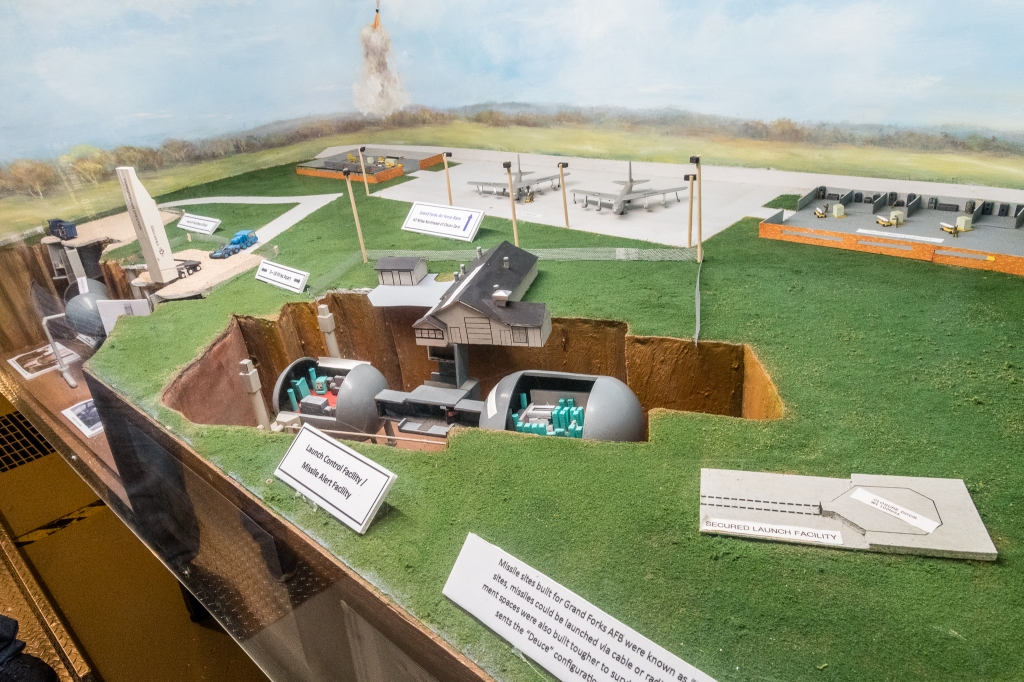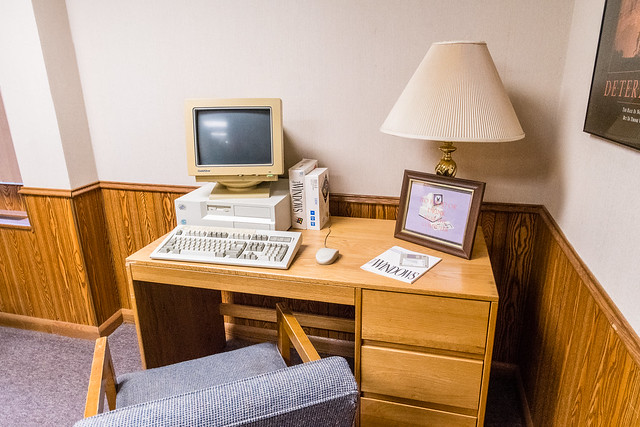
Cooperstown, North Dakota.
The mid-20th century was a dangerous time for the world. Cold war tensions and a nuclear arms race led to atomic bomb drills in schools and public buildings, and families built bomb shelters underneath their back yards. The upper midwest and North Dakota in particular were covered with missile launch sites that are now abandoned. Fortunately for historians, the Oscar Zero Missile Alert Facility and the November-33 Launch Facility were spared demolition and the two locations are now part of the Ronald Reagan Minuteman Missile State Historic Site.
We visited the Missile Control Facility just north of Cooperstown. The launch site is a few miles from the control site. The diorama above is a model of the alert facility. Guided tours are offered throughout the day and a knowledgeable docent provides a thorough description of the building and underground control facility in the center of the image above. There are no physical missile launch tubes on this site.
The tour starts with an overview of the region and the many missile sites throughout the area. The Oscar-Zero and November-33 sites were part of the 321st Missile Wing, a cluster of facilities located around the Grand Forks Air Force Base in North Dakota and the surrounding states.
In the building topside, a residence for the missileers was originally spartan, but the long duty times eventually led to a more home-like environment for the people on duty. The facility was in use until 17 July 1997 when it received its last alert.
This computer workstation was in the residential area where it could be used by off-duty personnel. There was no Internet as we know it when this computer was in use. A private area for making phone calls was also provided nearby.
This area topside is directly above the underground launch alert facility where on-duty personnel remained in contact with the crew of two that spent their shift in the bunker below. In the opening photo, you can see the area directly above the bunker has a cutaway of the elevator that takes the missileers down to the two separate nuclear-hardened bunkers.
After the long, slow ride in the elevator, the guests followed the tour guide into the first bunker which contained operational equipment for launch control. The blast door is about 3 feet (1 m) thick, as you can see by the open door frame in the photo above.
Probably the most interesting devices within each bunker are the large cylindrical shock absorbers. The top of the device is connected to the ceiling of the bunker. The bottom is connected to the floor which floats above the base of the concrete bunker. In case of a blast, these four absorbers, one in each corner of the floor, absorb the shock of the blast.
On the door frame to the other bunker, the Launch Control Center, a unit decal and note written with a marker memorialize the last alert date and time. As you can see, even short people like myself have to duck to enter each chamber. From this image, you can get a better view of the openings that match the large pins that seal the large door when it is closed.
In the Launch Control Center, two missileers sit at separate desks. That phone would ring at each desk and each operator would hear the coded message that could be a command to launch a missile strike. Several fail-safe methods were employed to ensure that a launch was truly being ordered by the only person in our government who could authorize such a launch, the President of the United States.
The second station is similarly equipped and the command would be delivered simultaneously to both stations. Following protocol, the sequence of events was strictly coordinated. The desks are too far apart for any one individual to launch a missile.
Each of the two stations has a module that contains the launch key switch. Both keys needed to be placed in their respective launch positions simultaneously before the missiles could be sent on their way to their predetermined targets.
The tour lasts about an hour and it is a fascinating look at how the facility managers, security forces, maintenance teams, and cooks lived their daily lives as they lived on the front lines of this country’s strategy of nuclear deterrence. For more information about the site and to make plans to visit, click here.
Feel free to click on any of the images above to see them in 2K HD in my Flickr album or you can go to the album page directly here.
John Steiner











It is also impressive that such a security scheme is put in place without us really knowing it. Thank you for showing it.
We learned a lot about cold War defense in that one-hour tour.
Wow, this post was as scary as it was interesting. As kids we had no concept of how close we were to massive destruction. Somehow bomb drills in the halls or under your desk with your hands over your heads didn’t carry the fear factor that was really there. Super post, John.
That historic site is one of the most interesting sites we’ve visited in recent times. The docent did a fantastic job telling us about how things were.
She mentioned how at two separate times, the world was saved by one person. In one case, it was an American, in another incident, it was a Russian.
Wow! I remember those times, but didn’t know details, of course. One of the museums I went to in Washington DC talked about Kennedy and how close we came. It might have been the Newseum. But it is something we should all remember and be mindful about. The missiles in the world seem so rogue now, probably since we are no longer fighting to be the leaders. Or maybe we are in secret. There are a lot of things we are probably better off not knowing if there’s nothing we can do about it.